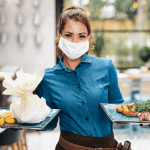With the advent of COVID-19 and the tumultuous consequences of its continued spread, the restaurant industry has been forced to drastically alter the way it thinks about cleanliness and sanitation in establishments. Sanitary procedures that more than sufficed in February were suddenly frighteningly inadequate in March. A host of previously overlooked restaurant touchpoints are now deserving of much greater attention.
Here are the top restaurant touchpoints that have vaulted to the forefront in this new age of COVID-19 prevention:
Hand hygiene
CDC guidelines on handwashing outline several important considerations to remember, including:
- Requiring frequent employee handwashing, including before, during, and after preparing food and after touching garbage).
- Use soap and water for at least 20 seconds and increase monitoring to ensure adherence.
- Glove use is only recommended when removing garbage bags or handling and disposing of trash and when handling used or dirty food service items, but any state or local requirements regarding glove use in restaurant operations should also be consulted.
- Employees should always wash their hands after removing gloves.
- Employees should be encouraged to cover coughs and sneezes with a tissue. Used tissues should be thrown in the trash and hands washed immediately with soap and water for at least 20 seconds.
- If soap and water are not readily available, use a hand sanitizer that contains at least 60% alcohol.
Front of house
Cleaning and sanitizing have always been the rule of thumb in foodservice. Procedures such as wiping surfaces with a wet cloth, cleaning surfaces with a glass or all-purpose cleaner, as well as the use of food-grade sanitizer continue to be common-sense precautions that should always be followed.
As a result of COVID-19, however, there is now an increased emphasis on disinfecting as opposed to sanitizing. Increased use of disinfectant is now the norm throughout restaurant facilities. In front of the house, the key staff and guest touch point recommendations include:
- Focus on high-contact areas touched by both employees and guests.
- Do not overlook seldom-touched surfaces.
- Follow sanitizing material guidance to ensure it is at effective sanitizing strength, and to protect surfaces.
- Between seatings, clean and sanitize table condiments, digital-ordering devices, self-service areas, tabletops, and common-touch areas.
- Avoid all food contact surfaces when using disinfectants. Tables are considered a food contact surface, so food safe sanitizers still need to be used between guests.
- Discard all single-use items. Consider using pre-rolled silverware.
- Remove lemons and unwrapped straws and utensils from self-service drink stations.
- Clean and sanitize reusable menus. If you use paper menus, discard them after each customer use.
- Check restrooms regularly, and clean and sanitize them based on the frequency of use.
- Make hand sanitizer readily available to guests. Consider touchless hand sanitizing solutions.
Restrooms
One of the most significant danger areas for virus spread is restrooms. Dirty restrooms can also have a significant impact on overall guest satisfaction. In restrooms, touchpoints that should be disinfected several times per day include fixtures, dispensers, and flush handles. Daily deep cleaning and disinfecting of every major surface and toilet bowl is recommended.
Back of house
As noted above, all food contact surfaces should be avoided when using disinfectants. Food safe sanitizers still need to be used on all food contact surfaces. Disinfecting followed by a potable water rinse needs to be done daily.
In addition to food-safe sanitizers, cooking and dishwashing are sufficient to remove viruses and bacteria from cookware and dishes, as heat kills viruses at about 140 degrees Fahrenheit.
Employee health
One of the most important ways to prevent the spread of the virus to staff and customers is to eliminate interaction by those who are (or maybe) infected. Pre-work screening for all employees should be the rule. Employees who become ill or present signs of illness should be immediately sent home. CDC guidelines should be followed as to when ill employees should stay home as well as when they may return to work. At a minimum, the employee should self-isolate for seven days from the onset of symptoms, and be symptom-free for three days without medication. The CDC has not mandated taking an employee’s temperature. Any operator who chooses to do so should engage health officials first and adopt policies aligned with proper procedures.
Social distancing
In addition to all of the above, customers and staff should continue to observe the social distancing principles that we’ve all become familiar with since the onset of the virus. Some important social distancing guidelines include:
- Not allowing guests to congregate in waiting or bar areas. This process can include floor markings, outdoor distancing, waiting in cars, etc.
- Limiting party size at tables to no more than the established “maximums approved” as recommended by CDC or approved by local and state governments.
- Installing physical barriers where practical, especially in booth seating sections.
- Consider a reservations-only or call-ahead-seating business model to more effectively space diners.
- Limit contact between wait staff and guests.
- If practical, physical barriers such as partitions or Plexiglas at registers are acceptable.
Use technology such as those solutions offered by OneDine where possible to reduce person-to-person interaction, including mobile ordering, server handhelds, texts on arrival for carry-out, and contactless payment.





